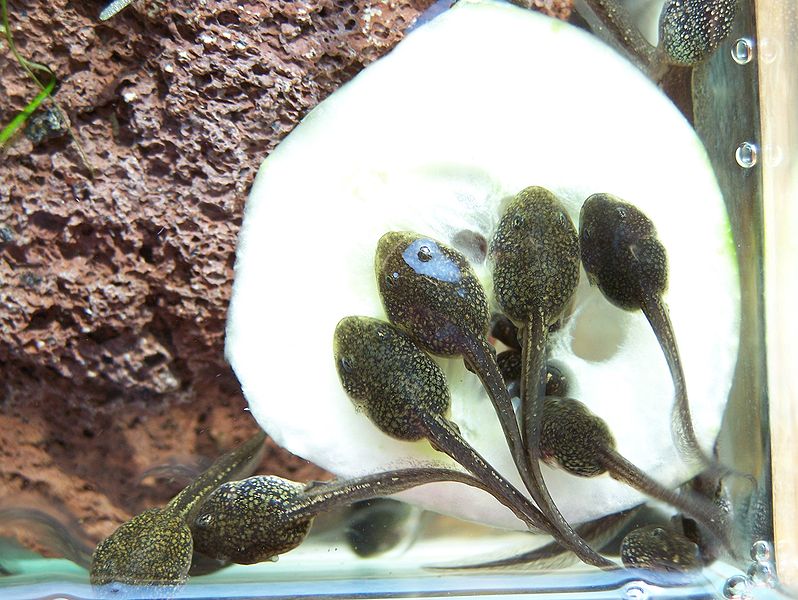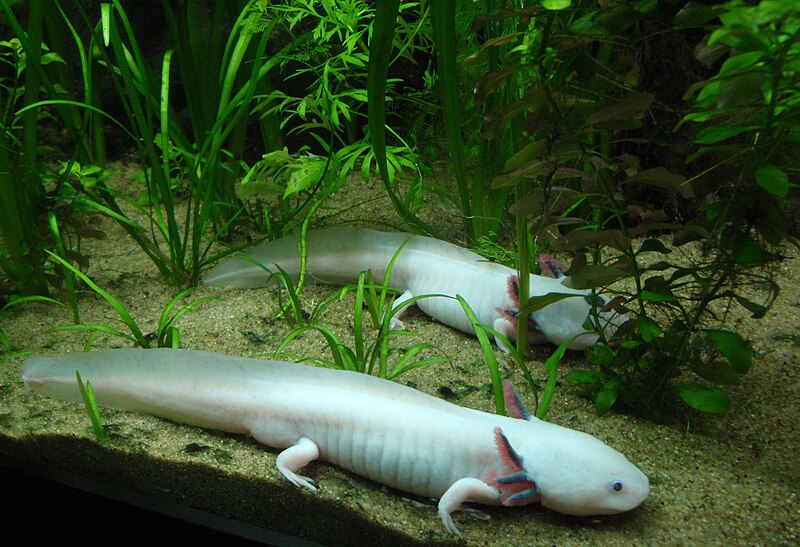 With their highly-permeable skins, amphibians absorb ammonia and other pollutants over a greater surface area than do fishes. Surinam Toads, Axolotls, tadpoles and other aquatic amphibians are most at risk from poor water quality, but even terrestrial species such as toads and Fire Salamanders can quickly succumb to water-borne toxins while soaking in terrarium pools. Keeping their water clean, both visibly and chemically, can be quite a challenge.
With their highly-permeable skins, amphibians absorb ammonia and other pollutants over a greater surface area than do fishes. Surinam Toads, Axolotls, tadpoles and other aquatic amphibians are most at risk from poor water quality, but even terrestrial species such as toads and Fire Salamanders can quickly succumb to water-borne toxins while soaking in terrarium pools. Keeping their water clean, both visibly and chemically, can be quite a challenge.
General Considerations
Natural History
Your pet’s natural history will determine the type of filter that should be used. For example, newts and Dwarf Clawed Frogs will be stressed by fast currents, Hellbenders are extra-sensitive to water quality, many species are prone to bacterial attack in highly-oxygenated waters, and so on. Please post below if you need help in selecting a filter.
Types of Filtration
Biological filtration, wherein aerobic bacteria convert ammonia to less harmful compounds (nitrites and nitrates), is the most important of the three basic filtration processes. Ammonia enters the water via dead animals and plants, uneaten food and the occupants’ waste products. The organisms involved in the process, Nitrosomas and Nitrobacter bacteria, live on substrates that are bathed with oxygenated water (i.e. gravel, filter pads).
Aerobic bacteria starter cultures may be purchased (i.e. Nutrafin Cycle) or obtained from the filter materials in a well-established tank. Always leave a bit of old material in your filter when changing carbon or filter pads, so that aerobic bacteria will seed the new filter medium.
Suspended solids and chemicals are removed from the aquarium through mechanical and chemical filtration.
Live Plants
Aquatic plants will assist filters in maintaining water quality and amphibian health. Pothos, Peace Lilies and other terrestrial plants that adapt to watery environments can also be used. Please do not discount the effects of live plants…I and many others can attest that they can make a real difference.
Water Changes
The use of a filter does not eliminate the need for regular water changes, as ammonia will accumulate even in well-filtered enclosures.
Undergravel Filters
 Yes, they are largely ignored today, but I believe this to be serious error. I have used undergravel filters to successfully keep a wide range of delicate amphibians, and have included them in several of the large zoo exhibits I’ve designed.
Yes, they are largely ignored today, but I believe this to be serious error. I have used undergravel filters to successfully keep a wide range of delicate amphibians, and have included them in several of the large zoo exhibits I’ve designed.
Undergravel filters transform the entire aquarium substrate into a biological filter. Water drawn through the gravel nourishes beneficial aerobic bacteria and inhibits the growth of harmful anaerobic species. The return tubes can be cut so that even a small pool in a terrarium can be filtered.
Undergravel filters are especially useful when rearing eggs, larvae and tadpoles, because they will not injure animals with suction and strong currents. Please see this article for detailed information on their use.
Corner or Box Filters
These “old-fashioned” inside-the-tank filters are actually quite effective if powered by sufficient airflow. I maintain a number of tanks using corner filters alone. In addition to providing mechanical and chemical filtration, these filters support aerobic bacteria that assist in ammonia detoxification.
Ideally, a corner filter should have low and high intake ports, so that water will be pulled from the very bottom of the tank and at a slightly higher level I recommend the Lee Triple Flow; most others lack low intakes. As a corner filters outflow is directed upwards, strong currents that might disturb eggs, larvae or weak-swimmers are avoided.
Corner filters can be easily hidden with plants. Live Java Moss is ideal for this purpose.
Sponge Filters
Sponge filters provide mechanical and biological filtration, and are ideal for use with amphibian eggs and larvae, and delicate specimens. They work well with African Clawed Frog tadpoles and other filter-feeders, as minute food particles are not rapidly removed from the water. This is also a consideration when salamander larvae are being reared, as many feed upon Daphnia, brine shrimp and other tiny creatures that may be pulled into more powerful filters.
The filter should be periodically cleaned by rinsing it in cool water (hot water will kill beneficial bacteria). Chemical filtration is not provided, so regular water changes are especially important.
Zoo Med Turtle Clean Canister Filter
 This powerful filter is designed with turtle-keepers in mind (please see this article for information on filtering turtle tanks). In common with fish canister filters, the Turtle Clean has ample chambers for carbon, filter pads and aerobic bacteria colonies, and is simple to clean. It is placed next to (not below) the tank, and can be used to create a waterfall effect.
This powerful filter is designed with turtle-keepers in mind (please see this article for information on filtering turtle tanks). In common with fish canister filters, the Turtle Clean has ample chambers for carbon, filter pads and aerobic bacteria colonies, and is simple to clean. It is placed next to (not below) the tank, and can be used to create a waterfall effect.
Despite its size and power, the Turtle Clean Filter can operate in as little as 2 inches of water, rendering it ideal for use in terrarium ponds or in shoreline-type setups housing American Bullfrogs, Leopard Frogs and similar species.
A powerful motor enables this filter to handle the copious wastes produced by Mudpuppies, Sirens, Amphiumas, Surinam Toads and other large amphibians. However, water can also be returned to the aquarium via a spray bar, so that newts and other small amphibians can also be maintained.
Supreme Ovation Submersible Power Jet Filter
The Supreme Ovation is first submersible, combined pump and filter to be marketed in the USA; my original unit operated continuously, under great strain, for approximately 20 years!
The four models currently available are extremely powerful, but are equipped with a movable outlet tube and a spray bar so that strong currents can be avoided. The largest (Model 1000) circulates 265 gallons per minute, yet is compact and easy to service.
Other Filters
Nearly all filters designed for use with tropical fishes can be of use to amphibian keepers. Although certain modifications may be required, many are worth investigating as a great deal of research has gone into their development.
You can check out 50+ aquarium filters options here. Please be sure to post your ideas, experiences and questions below.
Further Reading
Undergravel Filters in Terrariums and Aquariums
Ammonia Toxicity in Amphibians
Amphibian Lab Filtration Techniques
NutraFin Cycle: Bacteria in a bottle
Axolotls image referenced from wikipedia and originally posted by ZeWrestler
Tadpoles image referenced from wikipedia and originally posted by MarJon
 That Reptile Blog – Reptile, Amphibian and Exotic Pet Care and Information
That Reptile Blog – Reptile, Amphibian and Exotic Pet Care and Information



Hi. I have 2 firebelly newts in a 20 gallon filled up 2/3 of the way. I have a filter meant for a 7 gallon tank. I have 2 small plants, and will get some Indian fern in a couple weeks. I do weekly water changes. I add dechlorination liquid after every cleaning. Is this enough to keep ammonia levels down?
Hi Deena,
There are many variables…type of diet, type of filter, % water change, temperature, etc., so it’s not possible to say with certainty. But 2 newts in a 20 gallon is a good density; the volume of water is a plus, as are the plants. Java moss is a very good one to use also, and does well in low light, spreads rapidly. Regular water changes very inpt, and may be enough even if filter is small for the tank. Ammonia test strips are an effective way of keeping on top of ammonia levels…no need for more advanced kits, the test strips are specific enough for use with amphibs. Please let me know if you need further info. Enjoy, best, Frank
Dear Frank,
Thanks so much for the article, I have two Axolotls and plan on allowing mating come this spring…right now I have them in a 20 long aquarium filled half way and a 50 gal filter which I have flowing over slate and rocks to divert the flow….I feed them the smallest gold fish or rosies, earth worms or red wigglers, and sometimes shrimp pellets. I know when she lays her eggs I plan on removing them to a separate container in hopes to safe some, and when they get their front feet they become cannibalistic, so my question is…if I place them in individual bowls how do I filter it or…what is the best way to go so I can raise them? Also I have their water at 50 Degrees F should I allow the water to raise on its own come spring? I love these little guys…I have a male Golden Albino and a black female and hope to aquire more black little one’s.
Hi Michaelle,
Thanks..glad you enjoyed. You can let the water temp rise naturally…that is usually enough to stimulate them. They have hundreds of eggs, so individual rearing is not usually practical; you can set some that way, and do partial water changes without filtering. I’ve done so with poison frog tads…just dump 1/2 re-fill with dechlorinated water, etc.
You can limit cannibalism somewhat by providing lots of shelter…plastic aquarium plants with dense leaves, fish breeding grass etc….use plant ties to sink the plants to the bottom; scatter broken pieces of clay flower pots about as well, but plants generally provide the most shelter. Please see this article for more info, and please keep me posted. Enjoy, Frank
I love this article! I’m new-ish axolotl owner! Currently I have one little guy, about 4-5″ long who I am wanting to upgrade into a 20L tank. I’ve read about filters and whatnot, but actually making the purchase scares me in case I choose the wrong brand/model/size. Could you tell me what YOU would pick for an appropriate filter?